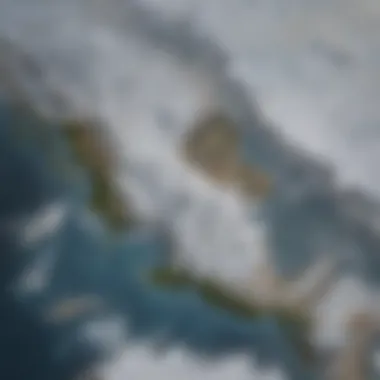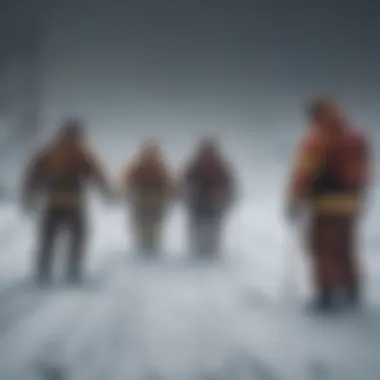Understanding the Blizzard: A Comprehensive Exploration


Intro
Blizzards stand out as some of the most intense and disruptive weather phenomena on Earth. Understanding blizzards involves examining their specific meteorological criteria, which separate them from other winter weather events. The conditions that qualify a storm as a blizzard are not solely based on snowfall amount, but also on wind speeds and visibility, leading to complex and sometimes hazardous situations.
In various regions around the world, blizzards occur with different frequencies and intensities. While some areas like the northeastern United States are particularly susceptible, others may experience them more sporadically. Analyzing these patterns gives insight into both natural occurrences and their consequences on human activities, infrastructure, and safety.
As climate change advances, the frequency and character of blizzards may evolve. This evolving nature underscores a necessity for understanding past occurrences, as well as future projections. Therefore, it is essential to anticipate their implications not just in a scientific sense, but in terms of how society can prepare better.
Overall, the intricacies of blizzards require a multi-dimensional analysis that embraces environmental science and meteorology. In the sections that follow, a more detailed exploration of these subjects will provide readers with a robust understanding of blizzards.”
Prelude to Blizzards
Blizzards represent some of the most complex forms of weather phenomena. Understanding them is crucial for multiple reasons. First, they present significant dangers to both life and property. As climate change alters our weather systems, knowing about blizzards may become increasingly vital. They impact various sectors including transportation, infrastructure, and economic stability. Increasing preparedness is one of the key benefits that come from a strong knowledge of these events.
Definition and Characteristics
A blizzard is defined by specific meteorological criteria. It typically includes heavy snowfall combined with strong winds. To characterize a blizzard, one must consider the three main factors: visibility, wind speed, and the amount of snow. Visibility is reduced to less than a quarter of a mile for an extended period due to blowing snow. Wind speeds usually exceed 35 miles per hour. The snowfall must be substantial, at least a few inches per hour, extending over a specific duration, like three hours or more.
Understanding these characteristics helps distinguish blizzards from other winter storms. Not all heavy snowfalls qualify as blizzards. Therefore, accurate definitions play an important role in scientific research as well as safety assessments during wintertime.
Historical Context
Considering the historical context of blizzards provides richer insight into their development and impact. Blizzards have had significant occurrences in various eras and locations. Notable examples include The Great Blizzard of 1888, which resulted in severe disruptions along the East Coast of the United States. It is noted not just for its ferocity but also for the subsequent changes in how meteorology is practiced. Prior to this event, forecasting systems were not well-developed. The need for accurate forecasting highlighted its importance as society relies heavily on weather predictions.
Moreover, climate history shows that some regions experience blizzards more frequently than others due to geographical and climatic factors. Knowledge gained from data over time informs policies and readiness for future blizzards. This history underscores the ongoing need for advances in technology to predict and study these significant weather events. Even today, continuous research into the patterns and consequences of blizzards remains essential.
Meteorological Conditions for Blizzard Formation
Understanding the atmosphere's role in weather events is essential for grasping why blizzards occur. Meteorological conditions are indeed the backbone of this phenomenon. A blizzard cannot simply materialize; it requires specific atmospheric elements that synthesize to create these extreme weather events. This section analyses the critical temperature, humidity, wind speed, and snowfall thresholds necessary for a blizzard to take shape, while also considering the differences between blizzards and other winter storms.
Temperature and Humidity Requirements
For a blizzard to form, specific temperature and humidity levels are crucial. Cold air is its primary ingredient. Typically, temperatures must drop below freezing, around 32 degrees Fahrenheit or 0 degrees Celsius. These colder temperatures allow snow to fall instead of rain, enhancing the conditions for blizzard formation.
Humidity also plays a critical role. Unlike common snow showers, which might occur with low humidity levels, blizzards need significant humidity. The air must be sufficiently moist to ensure that precipitation can fall as snowflakes instead of evaporating prematurely. When warm, moist air rises and interacts with cold air at higher altitudes, it creates powerful dynamics that result in snowfall. Thus, a delicate balance between temperature and humidity paves the way toward the harsh realities of blizzard conditions.
Wind Speed and Snowfall Thresholds
Another defining characteristic of a blizzard is the formidable combination of wind and intense snowfall. For a weather event to be classified as a blizzard, winds must reach at least 35 miles per hour. Such wind speeds not only propel snowflakes but also contribute to extreme low visibility levels, often plunging to less than a quarter of a mile.
Heavy snowfall is another critical component. Blizzards must manifest as heavy snow accumulation, typically in excess of 6 inches within a 24-hour period. This dual assault of snow and wind creates dangerous conditions, further complicating any efforts for communities to traverse through these areas. Conditions can go from dangerous to deadly quickly due to decreasing visibility and treacherous travel surfaces.
Comparison with Winter Storms
While blizzards fall under the umbrella of winter storms, they are more specific in their requirements and impacts. Comparing the two, winter storms can produce rain, sleet, or snow, but do not maintain the same velocity and severity criteria as blizzards.
In fact, a winter storm that brings light snow and moderate winds may not result in a blizzard. It is this unique combination of torrential snowfall and ferocious winds that distinctly marks a blizzard. Hence, understanding this delineation provides clarity in studying weather patterns and recognizing the appropriateness of weather responses.
A blizzard is defined by extreme winter weather conditions that include low temperatures, heavy snowfall, and fierce winds. Understanding these requirements is key to predicting their occurrence.


Gaining insight into the meteorological conditions that contribute to blizzard formation allows better preparation and mitigation. By distinguishing between snowfall types and establishing criteria, we can appreciate the complexities that lead to these fierce manifestations of winter.
Geographic Distribution of Blizzards
Understanding the geographic distribution of blizzards is crucial as it reveals patterns and trends in these severe weather events. Regions affected by blizzards typically have specific climatological conditions and topographical features that drive the formation and intensity of these storms. By identifying these areas, we can better prepare for their impacts and improve forecasting endeavors. Knowledge about blizzard regions also informs policymakers and emergency services, helping to mitigate risks and optimize responses during winter storms.
Regions Prone to Blizzards
Various regions across the globe are more susceptible to experiencing blizzards. In the United States, states situated in the northern part, like North Dakota and Minnesota, often record frequent blizzards. The Great Plains area also primes for significant blizzard events, due to its flat terrain that allows winds to attain high speeds with little obstruction. Other notable regions include the Northeast, particularly during the winter months, when nor'easters can produce heavy snowfall and extreme wind.
Around the world, parts of Canada and Eastern Europe also experience blizzard conditions. The country of Canada’s vast and harsh winter climate makes the provinces of Alberta and Saskatchewan particularly vulnerable. Additionally, countries like Norway and Sweden often face similar weather phenomena due to their geographic latitudes and seasonal cold fronts.
- U.S. Regions: North Dakota, Minnesota, Great Plains, Northeast
- Other Countries: Canada, Norway, Sweden
Impact of Elevation and Geography
Elevation and geographic features significantly affect the occurrence and severity of blizzards. As altitude increases, the temperature generally decreases. Higher elevations often experience increased snowfall and harsh conditions that can lead to blizzard formation. For instance, regions near the Rocky Mountains in the United States are noted for their intense snowfalls during winter, increasing the likelihood of blizzard conditions.
Also, geography plays a pivotal role. Coastal areas often have milder temperatures, leading to less common blizzard occurrences. In contrast, inland areas, especially those situated far from the moderating influence of oceans, can experience more severe winter storms. The wind patterns influenced by the surrounding geography can either mitigate or exacerbate conditions conducive to blizzards.
Impacts of Blizzards on Environment
Understanding how blizzards affect the environment is crucial. These severe weather events not only transform landscapes but also have lasting consequences on ecosystems. This section discusses the impact of blizzards on flora, fauna, and soil and water management challenges. Each element is imperative to grasp the full scope of blizzards’ environmental footprints.
Effects on Flora and Fauna
Blizzards create immediate and drastic changes to their surroundings. Heavy snowfall and strong winds can crush, break and even uproot trees, altering forest structures. The dense blanket of snow affects sunlight penetration, disrupting photosynthesis. As a result, plant growth and regeneration may decline following intense blizzard conditions.
Animals also face challenges during and after a blizzard. Certain species rely on foliage for shelter and access to food. The reduced visibility and cold temperatures force some wildlife into hibernation, while others struggle to find sustenance. Species that cannot adapt may face population declines in the aftermath. For instance, small mammals like rabbits find it difficult to reach food under dense snow cover.
In summary, biodiversity suffers in various ways. Some animals may not endure the extreme cold, easy prey can have population surges, and ecosystems become unbalanced. Thus, a blizzard can initiate changes with long-term ramifications for biodiversity.
Soil and Water Management Challenges
When blizzards occur, the ground undergoes various transformations. Prior to a blizzard, soil moisture levels generally reach saturation. Upon snowmelt after such storms, runoff increases significantly. This movement of water can lead to soil erosion. If not managed correctly, essential nutrients may wash away, compromising soil quality.
Moreover, thawing soils can undergo compaction. This impacts water infiltration, reducing its capacity to support plant life. Coupled with that, permafrost layers may be disrupted, leading to long-term changes in water retention capacities. Thus, heavy precipitation and rapid melting require comprehensive water management strategies.
In urban areas, flooding may arise from snowmelt. Streets and drainage systems may become overwhelmed. Hence, residents must address these challenges effectively measures to prevent water damage to property and infrastructure.
Societal Impacts of Blizzards
Blizzards present numerous challenges to society, influencing daily life, economic activities, and public health. These severe weather events become critical considerations for individuals, communities, and governments alike. The effects on infrastructure, the economy, and health services necessitate a thorough understanding.
Infrastructure Damage and Challenges
Blizzards can wreak havoc on infrastructure. Roads, bridges, and public transport systems become vulnerable to heavy snow accumulation and ice. Urgent maintenance and repairs become essential but often challenging during ongoing storms. For instance, public transit can face significant delays, affecting daily commuters and emergency services alike.
The aftermath may involve increased costs. Snow removal operations cost significant financial resources. Delays in repairs can cause prolonged disruptions that impact communities, raising questions about preparedness.
In some cases, utility companies must perform emergency fixes to damaged power lines, leading to extended outages. This affects heating systems, crucial during these cold months. The collaboration among governmental agencies, utility providers, and community organizations helps address these challenges, but adequate planning remains essential.


Economic Consequences
The economic impact of blizzards can be severe. Many businesses may temporarily close due to unsafe conditions, resulting in lost income. This fallout encompasses various sectors, from retail stores to agriculture. Revenue loss accumulates across the economy, potentially dragging down local markets.
Supply chain disruptions also occur, as snow affects deliveries. Perishable goods suppliers face especial threats, resulting in waste and financial losses. The construction industry often experiences delays as projects come to a halt. Past economic calculations regarding blizzards reveal hefty price tags for communities and governments trying to maintain operations.
Additionally, workers may lose wages during storm duration. Understanding these implications allows policymakers and businesses to create more resilient strategies moving forward.
Health Risks During Blizzards
Health risks become prominent during blizzard incidences. The immediate concern revolves around accidents and injuries from slips and falls on icy surfaces. Emergency rooms may witness increased traffic due to these incidents. Moreover, snow-related physical exertion can pose risks for many individuals, particularly those with preexisting health conditions.
Access to healthcare poses another dilemma. Road closures may hinder medical professionals’ ability to respond to urgent calls, delaying critical care. Patients waiting for treatments could compromise overall well-being under extreme weather conditions.
Psychological effects also materialize as the isolation and cabin fever take hold of those unable to leave their homes. Recognizing these health aspects is vital for communities preparing for, and managing, blizzard responses.
Blizzards not only disrupt daily life but also illuminate critical gaps in infrastructure and preparedness. Societal understanding is key to responding adequately to these events.
A comprehensive grasp of blizzard impacts on society empowers communities. Such awareness helps in developing strategies that minimize disaster effects. Preparedness planning stays at the forefront to ensure well-being in the face of weather challenges.
Safety Measures and Preparedness
Safety measures and preparedness are critical elements to effectively manage the risks associated with blizzards. These strategies not only minimize hazards during a blizzard but also protect lives. Evaluating and implementing such measures can create greater resilience in communities prone to severe winter weather.
Emergency Response Strategies
Emergency response strategies focus on a structured approach to responding to blizzards. Key elements often include:
- Establishing Emergency Services: Local governments should have well-defined roles and responsibilities for police, fire, and medical services during extreme weather events.
- Creating Response Plans: These should outline specific guidelines for snow removal, road closures, and distribution of resources like food and fuel.
- Collaboration with Other Entities: Working with groups such as the Red Cross and local non-profits can ensure effective delivery of services to the affected communities.
- Regular Training and Drills: First responders must conduct frequent training sessions that simulate blizzard conditions to prepare and enhance their readiness.
As part of a proactive approach, neighborhood organizations can assist by conducting local outreach to understand individuals’ needs during such times.
Public Education and Awareness Programs
Public education and awareness programs are fundamental for enhancing community resilience against blizzards. Effective strategies include:
- Informational Campaigns: Use of various channels to disseminate vital information about what blizzards are, their impact, and best practices for safety.
- Workshops and Seminars: Facilitated learning can help individuals on how to prepare emergency kits, plan evacuation routes, and create family communication plans.
- Social Media Outreach: Leveraging platforms like Facebook and Reddit can enhance communication and engagement among communities during blizzard emergencies.
- School Programs: Teaching children about blizzard preparedness ensures that future generations recognize the risks and prepare accordingly.
These programs foster an informed population, equipped to act swiftly in emergencies, minimizing potential risks and enhancing overall public safety.
Incorporating these measures ensures individuals know the signs of an impending blizzard, understand safety procedures, and know how to protect themselves and others effectively. Through vigilance and preparation, the impacts of blizzards can be mitigated considerably.
Case Studies of Notable Blizzards
Examining case studies of significant blizzards is essential for understanding the broader aspects of these phenomena. Such case studies illustrate patterns in storm development and behavior, while providing real-world contexts for scientific principles. They also underscore the impacts these extreme weather events have on society and the environment. Through detailed explorations of past blizzards, we can extract actionable lessons for disaster preparedness, infrastructure planning, and public safety initiatives.
The Great Blizzard of
The Great Blizzard of 1888, often referred to as the


Future Projections and Climate Change Implications
The analysis of future projections regarding blizzards is essential in comprehending how climate change alters weather patterns. Understanding these implications allows society to prepare better for potentially harsher and more frequent blizzard conditions, which can arise due to escalating global temperatures.
As the climate shifts, several factors may influence blizzard behavior. This includes changes in atmospheric circulation and increased moisture availability. It is crucial for those involved in urban planning, disaster management, and environmental protection to consider these trends. Enhanced awareness contributes to proactive measures against the challenges posed by blizzards.
Uncertainty remains regarding how often blizzards will happen or how ferociously they will strike. Scientific community highlights those variables that operate within complex models. It is often less conceivable to predict precise occurrences but trends might shape our understanding of implications moving forward. Risks from blizzards largely hinge on broader geophysical shifts influenced by human activity.
Trends in Blizzard Frequency and Intensity
Forecasting the frequency and intensity of blizzards requires robust climate modeling. Observations show variability in severe weather patterns over the decades, and this fluctuation will likely shape future trends. According to available data, some regions might witness a rise in both blizzard frequency and intensity.
- Warmer air holds more moisture, possibly leading to stronger snowfalls during winter events.
- Changes in wind patterns can amplify blizzard conditions, resulting in extreme weather anomalies.
- Previous analyses have suggested a cyclical nature to blizzard occurrences; however, climate change could disturb these natural cycles.
Moreover, region-specific studies are portrying the need for localized data collection. Each area may respond differently to shifting climatic conditions. Thus, understanding geographic sensitivities is vital for accurate assessments.
Potential Policy Responses
Adapting to the changing blizzard landscape requires comprehensive policy responses. Governments and local authorities must not only focus on short-term recovery but also invest in long-term preparation strategies.
- Infrastructure Resilience: Investments in sturdier roadways and transportation systems can reduce vulnerability during extreme blizzards. Proposal of redesigns that enhance snow removal and emergency routes might play a significant role.
- Disaster Preparation Education: Providing resources and programs that engage the community in blizzard awareness can save lives. Proper information sharing can blend with technology initiatives aimed to educate on best practices during a blizzard emergency.
- Climate Policies: Policymakers should prioritize climate sincere reforms that specifically address greenhouse gas emissions. This contributes to the fight against climate change, while indirectly impacting eventual blizzard conditions.
As research evolves, so too will the requirements for effective policy making. Collective efforts must prioritize scientific understanding in driving effective responses. This necessitates thorough collaboration between government bodies, researchers, and community stakeholders to navigate the forthcoming challenges provoked by changing weather patterns.
"Understanding blizzard projections within the context of climate change is not merely academic; it is essential for survival."
Through analyzing current trends and implementing proactive policies, adaptation to future blizzards can mitigate risks imposed by climate dynamics.
Finale
In the realm of meteorology, an in-depth analysis of blizzards serves a crucial role in both understanding natural phenomenon and preparing for their effects. The examination of blizzard attributes underscores their significance in our climate-stricken world. Blizzards are not merely temporary disturbances; instead, they are intricate intersections of temperature, wind speed, and moisture. Each plays a part in bringing forth impactful weather events that can shape landscapes and lifestyles.
The key points derived from this article cover vital areas such as the meteorological conditions necessary for blizzard formation, the geographic distributions prone to these events, and the societal and environmental ramifications.
Some core reasons defining the importance of this topic in today's context include:
- Climate Change Relevance: Projections indicate the possible increase in frequency and intensity of blizzards related to a warming climate.
- Human Impact Assessment: Such analysis aids communities in building resilience against extrem weather events, hence improving emergency and response efforts.
- Scientific Inquiry: It ignites curiosity and might drive future research focused on the long-term implications of blizzards on our environment and society.
Furthermore, understanding the dynamics of blizzards allows for better preparedness protocols which can save lives during sudden severe winter storms. Decision-makers can utilize this knowledge to formulate policies that enhance community safety and infrastructure durability.
Summary of Key Points
The exploration of blizzards reveals various significant findings:
- Blizzards necessitate specific combinations of temperature, winds, and precipitation to develop.
- Various regions, notably the northeastern United States, western Canada, and parts of Europe, show increased vulnerability to blizzard incidents.
- The environmental consequences span effects on flora, fauna, soil erosion, and seasonal water supplies.
- Societal impacts lead to damage to infrastructure, economic losses, and health risks emerging from exposure and forced isolation during blizzard spells.
This sums up how climate change may alter blizzard patterns in frequency and affected regions. The implications illustrated through case studies, such as the Great Blizzard of 1888, provide a unique lens into historical responses and predictions.
Final Thoughts on Future Research
The need for further investigation is paramount in comprehending blizzard phenomena, especially under changing climate conditions. Future research avenues include identifying relevant trends in operational meteorology to enhance forecasting practices, ensuring the preparedness of communities prone to extreme weather events.
In forthcoming times, integrating advanced technologies like AI-driven models might illuminate patterns previously missed in traditional studies. Collaborating between meteorologists, environmental scientists, and policymakers will enhance our comprehension of not just blizzards but other storm-related challenges, creating a holistic framework that favors proactive versus reactive policies. This pursuit promises to inform decisions impacting societal resilience, infrastructure integrity, and environmental health.
Blizzards will remain a topic of great relevance, with their complications only heightened by climatic shifts and human-directed variability. Ignoring these can have dire consequences as societies evolve.
Understanding blizzards may unlock keys to navigating our future climate situateons while benefiting scientific inquiry and human readiness.



